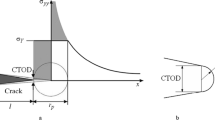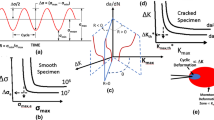Abstract
In practical design, the question of existence or non-existence of fatigue limit seems little more than an irrelevant academic discussion. Nevertheless, the answer affects many aspects of the fracture mechanics, such as, the calculation of damage accumulation; recognition of the multiplicity of fatigue mechanisms (and consequently, the multiplicity of S–N fields); interpretation of non-propagating cracks; and repercussion on the Kitagawa-Takahashi diagram. Various prestigious scientists deny the existence of a fatigue limit based on the results of failures in very high cycle fatigue (VHCF) regime, far below the high cycle fatigue (HCF) limit. However, the asymptotic extrapolation of the experimental results beyond the scope of testing with S–N models, cannot confirm or deny this hypothesis if those models do not fulfil indispensable physical and statistical requirements. Some phenomenological models based on solid statistical conditions (stability, limit conditions and compatibility), ensure the necessary existence of an asymptotic fatigue limit for each of the possible failure mechanisms. This may or may not be zero according to the experimental results but only the presence of an asymptotic fatigue limit can avoid the absurdity of fatigue failure under zero load value.






Similar content being viewed by others
Abbreviations
- \({a}_{i}\)::
-
Initial crack size
- FS::
-
Fatemi-Socie
- \(F(N;\,\varDelta \sigma )\)::
-
Cumulative distribution function of the number of cycles for a given stress range
- \(F(\varDelta \sigma ;\,N)\)::
-
Cumulative distribution function of the stress range for a given number of cycles
- GP::
-
Generalized parameter (driving force)
- HCF::
-
High cycle fatigue
- K–T::
-
Kitagawa-Takahashi (K–T)
- N::
-
Generic number of cycles
- \(N_{0}\)::
-
Limit number of cycles according to the Castillo-Canteli model
- \(N_{F}\)::
-
Number of cycles to failure
- \(N_{L}\)::
-
Limiting number of cycles specified in the fatigue design
- \(N_{T}\)::
-
Total number of cycles corresponding to the load spectrum
- SIF::
-
Stress intensity factor
- SWT::
-
Smith-Watson-Topper
- VHCF::
-
Very high cycle fatigue
- \(V=(log\,N/N_{0})\,(log\,\varDelta \sigma \,/\,\varDelta \sigma _{0})\)::
-
Normalized variable of the S–N field according to the Castillo-Canteli model
- \(\beta \)::
-
Weibull shape parameter
- \(\lambda \)::
-
Weibull location parameter
- \(\delta \)::
-
Weibull scale parameter
- \(\varDelta \sigma _{lim}\)::
-
Fatigue limit
- \(\varDelta \sigma _{lim,fct}\)::
-
Factual fatigue limit, i.e. fatigue resistance for a defined number of cycles \(N_{L}\)
- \(\varDelta \sigma _{max}\)::
-
Maximum stress range
- \(\varDelta \sigma \)::
-
Generic stress range
- \(\varDelta \sigma _0\)::
-
Asymptotic fatigue limit, as a model parameter of the model of Castillo-Canteli
- \(\varDelta K_{th}\)::
-
Threshold value of the stress intensity factor
References
Basquin OH (1910) The exponential law of endurance tests. Proc ASTM 10(2):625–630
Bathias C (1999) There is no infinite fatigue life in metallic materials. Fatigue Fract Eng Mater Struct 22:559–565
Bathias C (2006) Piezoelectric fatigue testing machines and devices. Int J Fatigue 28:1438–1445
Bathias C, Drouillac L, Le François P (2001) How and why the fatigue S–N curve does not approach a horizontal asymptote. Int J Fat 23:S143–S151
Bolotin VV (1981) Wahrscheinlichkeitsmethoden zur Berechnung von Konstruktionen. Verlag für Bauwesen, Berlin
Bolotin VV (1998) Mechanics of fatigue. CRC Press, Boca Raton
BS 7608:2014+A1 (2015) Guide to fatigue design and assessment of steel products. The British Standards Institution, London
BS ISO (2003) 12107–2003, Metallic materials–fatigue testing–statistical planning and analysis of data. International Organization for Standardization, Geneva
Castillo E, Fernández-Canteli A (2001) A general regression model for lifetime evaluation and prediction. Int J Fract 107:117–137
Castillo E, Fernández-Canteli A (2009) A unified statistical methodology for modeling fatigue damage. Springer, Berlin
Castillo E, Iglesias A, Ruíz-Cobo R (2005) Functional equations in applied sciences. Elsevier, Amsterdam
Castillo E, Ramos A, Koller R, López Aenlle M, Fernández Canteli A (2008) A critical comparison of two models for assessment of fatigue data. Int J Fatigue 30:45–57
Castillo E, Muniz-Calvente M, Fernández-Canteli A, Blasón S (2019) Fatigue assessment strategy using Bayesian techniques. Materials 12:3239. https://doi.org/10.3390/ma12193239
Chao M, Fuh C (2001) Bootstrap methods for the up-and-down test on pyrotechnics sensitivity analysis. Stat Sin 1:1–21
Chernick M (1999) A practitioner’s guide. Wiley, Hoboken
Ciavarella M, Monno F (2006) On the possible generalizations of the Kitagawa-Takahashi diagram and of the El Haddad equation to finite life. Int J Fatigue 28:1826–1837
Davidson A, Hinkley D (1997) Bootstrap methods and their application. Cambridge University Press, Cambridge
DNV-RP-C203 (2011) DNV-RP-C203, Fatigue design of offshore steel structures. Det Norske Veritas, Norway
Efron B, Tibshirami R (1993) An introduction to the bootstrap. Chapman & Hall, New York
El Haddad MH, Topper TH, Smith KN (1979) Prediction of non-propagating cracks. Eng Fract Mech 1:573–84
EN 1993-1-9 (2005) Eurocode 3: design of steel structures–part 1–9: fatigue. European Committee for Standardization, Brussels
Fernández-Canteli A, Brighenti R, Castillo E (2012) Towards a probabilistic concept of the Kitagawa-Takahashi diagram. In: The 4th conference on crack paths, 19–21 September, Gaeta
Fernández-Canteli A, Przybilla C, Nogal M, López Aenlle M, Castillo E (2014) ProFatigue: a software program for probabilistic assessment of experimental fatigue data sets. Proc Eng 74:236–241
FKM Guideline (2013) Analytical strength assessment of components in mechanical engineering, Forschungskuratorium Maschinenbau
Freudenthal AM (1946) The statistical aspect of fatigue of materials. Proc R Soc A 187(1011):416–429
Freudenthal AM, Gumbel EJ (1956) Physical and statistical aspects in fatigue. In: Dryden HJ, Von Kármán TH (eds) Advances in applied mechanics, vol IV. Academic Press, Cambridge, pp 116–160
Kitagawa H, Takahashi S (1976) Applicability of fracture mechanics to very small cracks or cracks in the early stage. In: Proceeding of the 2nd international conference on mechanical behavior of materials, ASM, pp 627–631
Muniz-Calvente M, Fernández-Canteli A, Pyttel B, Castillo E (2017) Probabilistic assessment of VHCF data as pertaining to concurrent populations using a Weibull regression model. Fatigue Fract Eng Mater Struct 40:1772–1782
NIMS Fatigue Data Sheet No. 98 (2005) Data sheet on giga-cycle fatigue properties of Ti -6Al-4V (1100 MPa class) titanium alloy. National Institute for Materials Science, Tokyo
Nishijima S (1979) Statistical fatigue properties of some heat-treated steels for machine structural use. In: Little RE, Eckwall JC (eds) Statistical analysis of fatigue data. ASTM STP 744, pp 75–88
Paolino DS, Chiandussi G, Rossetto M (2012) A unified statistical model for S–N fatigue curves. Fatigue Fract Eng Mater Struct 36(3):187–201
Paolino DS, Tridello A, Geng HS, Chiandussi G, Rossetto M (2014) Duplex S–N fatigue curves: statistical distribution of the transition fatigue life. Frattura ed Integrità Strutturale 30:417–423
Pessard E, Bellett D, Morel F, Koutiri I (2016) A mechanistic approach to the Kitagawa-Takahashi diagram using a multiaxial probabilistic framework. Eng Fract Mech 109:89–104
Pyttel B, Schwerdt D, Berger C (2011) Very high cycle fatigue—is there a fatigue limit? Int J Fatigue 33:49–58
Pyttel B, Fernández-Canteli A, Argente Ripoll A (2016) Comparison of different statistical models for description of fatigue including very high cycle fatigue. Int J Fatigue 93:435–442
Sonsino CM (2007) Course of SN-curves especially in the high-cycle fatigue regime with regard to component design and safety. Int J Fat 29:2246–2258
Stanzl-Tschegg S, Schönbauer B (2007) PSB threshold and fatigue limit of polycrystalline copper in the VCHF-regime. In: Proc VHCF 4, Ann Arbor, pp 15–22
Suresh S, Ritchie RO (1984) Propagation of short fatigue cracks. Int Met Rev 29(6):445–476
Author information
Authors and Affiliations
Corresponding author
Additional information
Publisher's Note
Springer Nature remains neutral with regard to jurisdictional claims in published maps and institutional affiliations.
Rights and permissions
About this article
Cite this article
Fernández-Canteli, A., Blasón, S., Pyttel, B. et al. Considerations about the existence or non-existence of the fatigue limit: implications on practical design. Int J Fract 223, 189–196 (2020). https://doi.org/10.1007/s10704-019-00413-6
Received:
Accepted:
Published:
Issue Date:
DOI: https://doi.org/10.1007/s10704-019-00413-6




